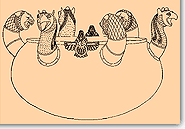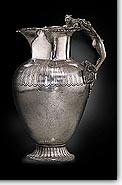





     | |
|
|
 | Already from the beginning of the |
According to ancient writers, many large vases of precious metals were dedicated to the Panhellenic sanctuaries by the kings of Lydia, such as Gyges and Croesus. Herodotus refers with admiration to oversized gold and silver craters of Samian manufacture. For many years only a gold phiale, a dedication of Cypselids in Olympia, and a silver kantharos from Rhodes were known from the early toreutics works of precious metals. However, it was recently proved that a group of exquisite silver vases of the middle of the |  |
With the exception of lebes, few things are known about the bronze vases of the workshops in Asia Minor. Some large vases (amphoras, kadoi, hydriai) that have been found in Macedonia and Scythia are attributed by some scholars to Ionia. From the small vases of the end of the 7th century some bronze "plates" with engraved decoration are notable, although their attribution to Ionia or Corinth is still being debated by the specialists. Neither have many metallic vases survived from Attica and the fragmentary findings of Acropolis have not contributed greatly to the identification of the Attic types, since the sanctuary attracted many pilgrims, especially Ionians. At the end of the Archaic period lebes and hydriai were manufactured and were often used as ash urns. |
|
| |
|
Note: Click on picture for short description. | |